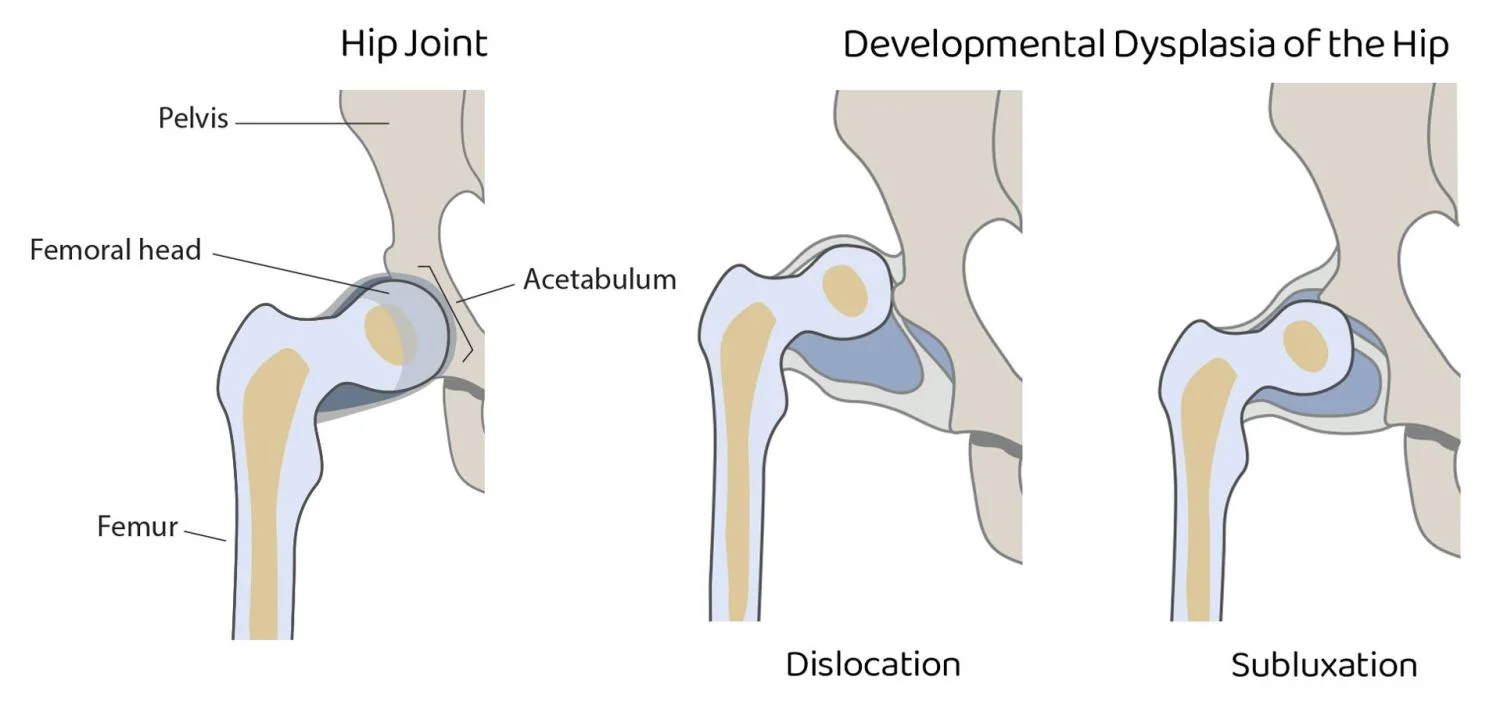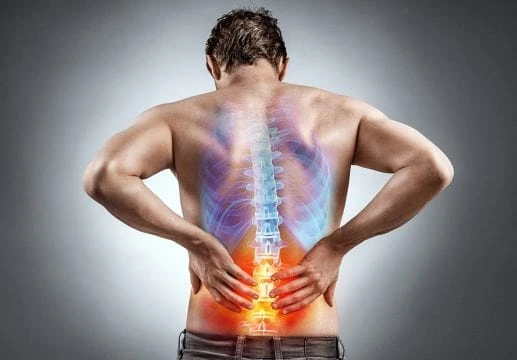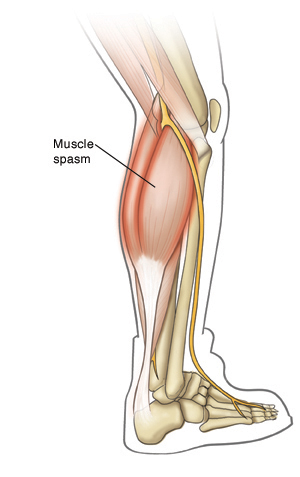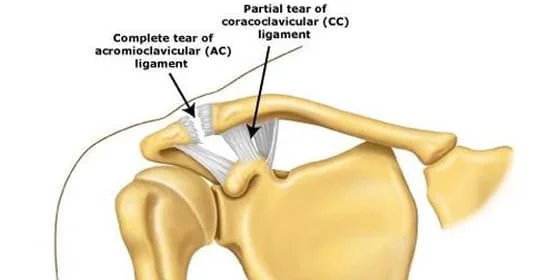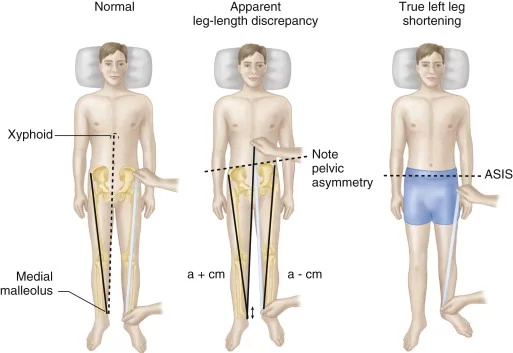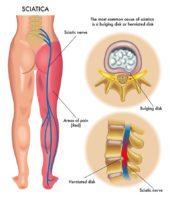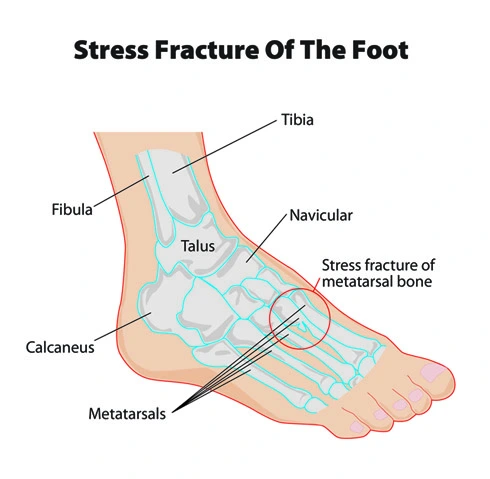Hip Subluxation
Table of Contents
Introduction:
Hip subluxation refers to a partial or incomplete dislocation of the hip joint. In a healthy hip joint, the ball-shaped head of the femur (thigh bone) fits securely into the socket of the pelvis called the acetabulum. However, in cases of subluxation, the femoral head partially slips out of the acetabulum, causing instability and misalignment of the joint.
The rounded head of the femur (thigh bone) inserts into the socket-like acetabulum of the pelvis to form the hip joint, which is a ball-and-socket joint. A subluxation happens when the ball partially slips out of the socket, disrupting the normal alignment of the joint.
Trauma, congenital abnormalities, neuromuscular diseases, and recurrent stress on the hip joint are only a few of the causes of hip subluxation. The risk of subluxation may occasionally be increased by weak or injured ligaments and soft tissues surrounding the hip joint. On the affected side, this may result in discomfort, spasm, and difficulties bearing weight.
A dislocation happens when the bones in a joint are split or knocked out of place, whereas subluxation occurs when the bones in a joint are separated or knocked out of place. Subluxation occurs progressively over time due to decreasing muscular tone, spasticity, or motor vehicle crashes.
The hip is one of the largest joints in our body, the hip plays a crucial role in maintaining stability and balance. The hip is a ball-and-socket joint, one that has a rounded head at the top of your thighbone and a socket that reaches a cup in your pelvis.
These two parts are protected by thick layers of cartilage, which protects the bone and allows the hip to move quickly. A dislocated hip occurs when the femur slips out of the hip socket. A traumatic injury or medical condition usually causes this condition.
What is the Anatomy of the Hip?
The hip is a ball-and-socket type of joint. The ball is the top of the femur (top of the thigh bone), and the socket is the section of the pelvis that meets the upper part of the thigh bone. When this joint is functioning correctly, the ball glides freely in the socket and the leg moves freely.
When the ball is slightly out of the socket, as in hip subluxation, the range of motion of the hip is limited and the development of the femur and hip bone is altered. A subluxated hip can become dislocated over time when the hip is no longer in its socket.
Any hip injury or disease will limit the joint’s range of motion and capacity to bear weight.
The hip joint is made up of the following components:
- Joints and bones
- The joint capsule’s ligaments
- Tendons and muscles
- The blood vessels and nerves that supply the muscles and bones
How does the Hip Joint Work?
The hip appears as a socket that receives the thigh bone’s head. The socket supports the bone to rotate, allowing you to move your hips and thighs normally. The entire function of the socket-to-head of the femur connection is mechanical.
The thigh bone’s head is a perfect fit for the socket. Mobility and hip function is lost if the head is entirely pulled out of the socket. When the head is partially pulled out, the hip and leg continue to operate, but they lose their entire connection for normal motion. This results in hip subluxation, which causes a variety of undesirable symptoms.
The hip joint is an important connection, and the subluxation is not limited to the hip. A hip subluxation affects major muscle groups and can cause pain and discomfort in the lower back and spine. It eventually develops into an alignment problem that can cause discomfort in your body, so pay attention to the hip dislocation indicators to work on an immediate cure.
What is partial Hip Dislocation (Subluxation)?
A hip subluxation occurs when your ball joint moves only partially out of its socket. It is more common in patients with hip dysplasia or who have had a hip replacement.
A subluxation can be classified as either minor or severe:
- Milder cases
- this could be due to general wear and tear on your hip
- May be chronic or recurring
- You might be able to put in it yourself
- Severe cases
- Tends to be caused by injury
- Can be as painful
- An expert may be required to reset the system
What are the types of Hip Subluxation?
Anterior Hip Subluxation: In this type, the femoral head moves forward and partially slips out of the front of the acetabulum. It is often caused by a sudden forceful movement or trauma to the hip joint, such as a fall or a direct blow to the hip. The anterior hip subluxation can be associated with injuries to the surrounding soft tissues, including the labrum (cartilage rim) of the hip joint or the ligaments.
Posterior Hip Subluxation: In posterior hip subluxation, the femoral head moves backward and partially slips out of the back of the acetabulum. It is less common than anterior subluxation and is often associated with high-energy trauma, such as a car accident or a significant force applied to the hip joint from the back. Posterior hip subluxation can also result in injuries to the labrum, ligaments, and other surrounding structures.
Lateral Hip Subluxation: Lateral hip subluxation involves the femoral head shifting partially out of the side of the acetabulum. It is relatively rare and can occur due to severe trauma, such as a dislocation or fracture of the pelvis. Lateral hip subluxation is often associated with significant damage to the soft tissues, including the joint capsule, labrum, and ligament.
What are the causes of Hip Subluxation?
The etiology of hip subluxation can be multifactorial and may involve various underlying causes. Here are some common etiological factors:
- The hip subluxation can be caused by a variety of congenital disorders. In cases of developmental dysplasia of the hip (DDH), the hip joint may be shallow making it more prone to subluxation.
- The hip joint may become subluxated as a result of a significant blow or force. This could happen as a result of traumatic experiences like sports, falls, car accidents, or other traumatic situations.
- Hip subluxation risk may be increased in people who naturally have more flexible joints or generalized ligamentous laxity. Joint laxity can be exacerbated by diseases that damage connective tissues.
- Weakness or abnormalities in the hip-supporting muscles, especially the hip abductor muscles (such as the gluteus medius and minimus), can cause hip instability and subluxation. These imbalances may be brought on by weakened muscles, neuromuscular conditions, or insufficient post-injury therapy.
- Repeated pivoting, twisting, or other stress of the hip joint, as in several sports or other activities, can eventually cause hip instability and subluxation.
- Certain neurological diseases, such as cerebral palsy, spinal cord damage, or stroke, can impact the muscle control and coordination surrounding the hip joint, increasing the risk of hip instability and subluxation.
What are the signs and symptoms of Hip Subluxation?
Common signs and symptoms include:
- Joint swelling
- Pain in the joint
- Spasms over the thigh and buttocks
- Bruising
- Difficulty moving the leg
- Tingling
- Numbness
- Muscle weakness
- Difficulty walking
- The hip is visibly out of place
- Difficulty standing or bearing weight on the affected hip
- The leg on the side of the affected hip side may appear shorter and may be bent inward or outward
How is Hip Subluxation diagnosed?
X-rays: Hip dislocations are frequently visible on standard AP (anteroposterior) pelvic imaging. However, comprehensive imaging usually includes a cross-table lateral of the affected joint.
The femoral heads of a proper AP pelvis should be equal in size, with symmetric joint spaces. An anterior dislocation will cause the femoral head to seem larger. This imaging should rule out a femoral neck fracture before doing a reduction.
Judet views (45-degree internal and external oblique views) may be of some help in evaluating bone fragments and occult acetabular and femoral head and neck fractures.
CT (Computed Tomography): After a successful closed hip reduction, CT (Computed Tomography) is advised to evaluate for occult fractures. It may also help to determine the reason for post-reduction joint gap widening and identify intra-articular bone fragments or soft tissue injuries that may limit proper joint articulation. Identified loose bodies in 20% of hips during post-reduction CT.
When a closed reduction is not possible and surgical, open reduction is required, CT may be useful in preoperative planning. Findings on CT after unsuccessful reduction attempts, similar to postreduction joint space widening, could identify bone fragments or soft tissue anomalies that explain the inability to accomplish a closed reduction and help in surgical planning.
MRI: An MRI may be required to evaluate soft tissue injuries and cartilaginous structures that remain after the acute period. Osteonecrosis can also occur in the subacute period (4 to 8 weeks), and some propose that MRI is superior to CT for children with hip injuries while CT can detect unossified labrum and acetabular fractures.
Other Testing: Laboratory studies should be tailored to the individual patient; however, if significant blood loss is suspected due to femoral vessel injury, or serial hemoglobin/hematocrit, a type, and screen may be requested.
How is Hip Subluxation treated?
Treatment depends on the degree of subluxation and other associated injuries (if the femur is fractured, other soft tissue injuries, etc.) that affect treatment.
If the femur is not broken, specialists may be able to repair a subluxated hip without surgery. This is a conservative treatment. After giving medication to relax the muscles and make the patient comfortable, the doctor moves the top of the femur. This is known as joint reduction. They may also perform an X-ray to verify that the joint is properly positioned.
If the femur fractures, surgery may be required. Screws or nails may be used by the specialist to hold the fracture together. If the top of the femur is injured, they may need to replace a few hip parts. In serious cases, a total hip replacement may be required.
After the subluxation has been fixed, the doctor may prescribe pain and inflammation medications. Patients may also need to need assistance for a short period. Physiotherapy may be indicated to avoid future hip wounds. This may help in the healing of tendons and muscles as well as a restoration of range of motion.
Exercise for Hip Subluxation
Passive Treatment:
Before consulting a doctor, a generally restricted hip subluxation can require more passive treatment methods. Simple stretches and lifestyle adjustments can assist in getting the hip back into its socket. An extreme example, on the other hand, will require the assistance of a specialist. When the hip can no longer sustain weight, passive therapy is no longer an option.
Stretching provides the basis for your passive therapy, but overstretching can aggravate a subluxation, so keep it gentle. The goal is to release the supporting muscles while moving the femur head softly until it correctly resets into the hip joint.
Home stretching programs are frequent, but physical therapy is another alternative to ensure you aren’t overextending your hip. The goal is to restrict the range of motion while minimally exercising and moving the hip and leg. Stretching the lower back, thighs, and hamstrings is also a good practice to keep the supporting muscles in place as your hip and leg work their way back into place.
Stretching and Range of Motion:
Gentle stretching motions can help lubricate joint surfaces and make movements smooth and easy. These exercises will take the hip through all of its ranges of motion. Hip abduction is the movement of the leg away from the body at the hip joint, while hip adduction is the movement of the leg towards the body at the hip. External rotation (which rotate the hip away from the body) and internal rotation (rotating the hip inward) are both significant ranges of motion for hip joint performance.
Strengthen the Supporting Muscles:
Strength workouts can also benefit the supporting muscles. This may help to tighten the ligaments and keep the femur in the socket more securely. Muscle-building exercises are used in physical treatment programs, but you may easily carry them home once your therapy is finished.
Knee raises, for example, are a type of low-impact standing exercise that may be performed anywhere. This works the hip socket without causing undue strain. Including them in your everyday morning routine will warm up your hips before you begin your day’s activities.
Many exercises are also performed while lying down. Strength can be increased by performing leg lifts while lying flat on your back. To work the hip abductors, lie on your side and lift the upright leg. Increasing the strength of the abductors can help.
How can I stop my Hip Subluxation again?
- Use high armchairs and a high toilet seat (about 24 inches high).
- Place an extra mattress or blocks under the feet of your bed to raise it to around 24 inches.
- Do not bend the hips above 90 degrees.
- Don’t cross your legs.
- Place a pillow between your knees.
- If you need to pick up something from the floor, lean towards a piece of furniture.
What is long-term Care for Subluxation?
Long-Term Subluxation Treatment:
Many people are affected by subluxation. The hip and femur split just enough to create discomfort, and the spine alignment is thrown off in the process.
The key to living with subluxation while minimizing the consequences and impact on your health is to make lifestyle modifications. Stretching helps, but so can change your diet and muscle-building workouts.
Overweight people who have hip subluxation can lose weight by changing their eating habits. Less weight on the hip means less strain on the joint and the femur. By just doing a healthy dietary change, the risk of subluxation is lowered.
Prognosis:
The prognosis for hip subluxation varies depending on the underlying cause, the subluxation’s severity, and the treatment’s effectiveness. Early detection and appropriate management are important in preventing long-term complications, such as chronic pain, hip instability, and degenerative joint changes.
Summary:
Hip subluxation refers to the partial or incomplete dislocation of the hip joint, where the ball-shaped head of the femur partially slips out of the socket of the pelvis. This condition can result from various causes, including trauma, congenital hip dysplasia, neuromuscular disorders, or repetitive stress on the joint.
The severity of the hip subluxation can range from mild to severe, with accompanying symptoms such as pain, instability, limited range of motion, and difficulty walking. In cases of hip subluxation, the hip joint is not fully dislocated but has an abnormal position, which can lead to chronic pain and functional impairment. The condition often requires medical intervention to alleviate symptoms and prevent further damage to the joint.
FAQ:
What is the difference between subluxation and dislocation?
Subluxation and dislocation are terms used to describe different forms of joint injury. When two adjacent bones are moved slightly out of place but still touch, this is known as a subluxation. When they no longer touch, this is known as a dislocation. A subluxation occurs when the femoral head is partially out of its socket, while a dislocation occurs when it is completely out of its socket.
Can subluxation occur in any joint?
Subluxations can occur in any joint in the body, but they are most commonly seen in the shoulder, elbow, hip, knee, and finger joints. However, any joint with the potential for movement and susceptible to injury can experience subluxation.
Can walk with a hip subluxation?
A less severe example may be caused by general hip wear and tear, in which the cartilage that helps seal your joint in its socket has degenerated. It could be chronic or recurrent. You may still be able to walk if you have a mild subluxation, and you may be able to pop it back into place yourself with slight stretching.
What are the complications of hip subluxation?
Avascular necrosis (bone death) and sciatic nerve injury are the most serious complications associated with hip subluxation. The sciatic nerve runs from the lower back to the upper thigh, where it separates into the tibial and common peroneal nerves, which allow ankle and toe movement.
Can subluxation be self-treated?
While self-care measures such as rest, applying ice or heat, and over-the-counter pain medications can help alleviate symptoms temporarily, it is important to consult a healthcare professional for an accurate diagnosis and appropriate treatment. They can provide specific guidance and interventions based on your condition and the joint involved.
How long does a hip subluxation take to heal?
It can take up to 3 months for the hip to recover following a subluxation. If there are more fractures, the rehabilitation time may be extended. To protect the hip from subluxation again, the doctor may advise limiting hip mobility for many weeks. Physical therapy is frequently required during the rehabilitation process.

